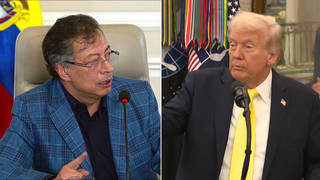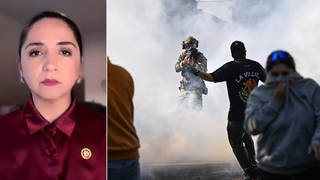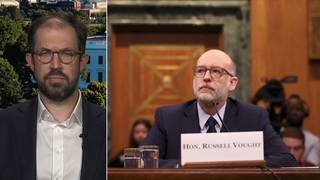
Californians overwhelmingly rejected a Republican-led recall effort against Democratic Governor Gavin Newsom on Tuesday that cost close to $300 million in taxpayer funds. The failed recall was seen as a battle against the far right and a referendum on several key issues ahead of the 2022 midterms, including the pandemic, immigrant rights, the climate crisis and the related unhoused crisis. California voters cast their ballots in the recall because “as attention started being focused nationally on this election, people started realizing what was at stake,” says Sasha Abramsky, “Left Coast” correspondent for The Nation. “There was this real risk that California could sort of almost accidentally stumble into a far-right governorship,” Abramsky says.
Transcript
AMY GOODMAN: Californians overwhelmingly rejected a Republican-led recall effort against Democratic Governor Gavin Newsom Tuesday. The failed recall attempt cost close to $300 million in taxpayer dollars and was seen as a battle against the far right. Speaking from the California Democratic headquarters in Sacramento, Newsom thanked voters and criticized former President Trump’s claim the recall was rigged.
GOV. GAVIN NEWSOM: I want to focus on what we said yes to as a state. We said yes to science. We said yes to vaccines. We said yes to ending this pandemic. We said yes to people’s right to vote without fear of fake fraud or voter suppression. We said yes to women’s fundamental, constitutional right to decide for herself what she does with her body, her fate and future. We said yes to diversity. We said yes to inclusion. We said yes to pluralism. …
You know, we may have defeated Trump, but Trumpism is not dead in this country: the big lie; the January 6 insurrection; all the voting suppression efforts that are happening all across this country; what’s happening, the assault on fundamental rights, constitutionally protected rights, of women and girls. It’s a remarkable moment in our nation’s history.
AMY GOODMAN: The attempt to recall Governor Newsom was seen as a referendum on several key issues, and Democrats at the national level closely watched the race ahead of the 2022 midterms. Early exit polls show Latinos make up to 25% the electorate, responding in part to the anti-immigrant views of Newsom’s leading Republican challenger, right-wing radio host Larry Elder. Elder conceded Tuesday night but vowed to run again, saying, quote, “We may have lost the battle, but we’re going to win the war.” Governor Newsom faces reelection next year.
For more, we go to Sacramento, the capital of California. We’re joined by Sasha Abramsky, “Left Coast” correspondent for The Nation who’s been closely following this recall attempt.
Welcome back to Democracy Now! So, the final vote isn’t in, Sasha, but it looks like a two-to-one trouncing, not something the Democrats thought along the way. Can you talk about what decided this and elevating this to a national level and taking on Elder as a surrogate for Trump, essentially?
SASHA ABRAMSKY: Yeah. Good morning. You know, you’re right. I think most people didn’t predict this, and I certainly didn’t. I was following the polls for the last three months, and I was writing about what could happen. And for the last three months, there were these sort of two different lines going on in the polls. So, one line was all voters in California. And right from the get-go, Newsom was ahead on that one, because this is a very, very blue state, and, broadly speaking, Newsom’s policies, on climate change, on COVID vaccines, on abortion and so on, gel with the majority of Californians’ ideas about what kind of society they want to live on. But the second line was likely voters. And in July and August, you saw this sort of massive contraction of Newsom’s lead. And in a lot of polls, especially about six weeks ago, Newsom was actually trailing. He wasn’t crossing that 50% threshold to survive the recall.
I think what happened over the last month or so was Californians began paying attention. And California makes it easy to vote. You don’t have to jump through hoops like you do in Texas or Georgia or many of these other states that have imposed these restrictions. In California, you get mailed a ballot. In other words, the state makes it easy for you to vote. And what happened was, as the ballots came into people’s mailboxes, as attention started being focused nationally on this election, people started realizing what was at stake. That didn’t mean that as many people were going to vote as voted in the presidential election, but instead of it being a sort of catastrophically low voter turnout, more and more people said, “All right, I’m a likely voter here. This is easy. All I have to do is mail in a ballot. And the issues are important.”
And Larry Elder was a brilliant foil for Newsom, because Elder’s policies, they’re to the right of Greg Abbott’s policies in Texas. I mean, this guy is so far right-wing. And there was this real risk that California could sort of almost accidentally stumble into a far-right governorship. And I think Newsom played it very well, that he sort of used Elder relentlessly as his foil, and he managed to focus and coalesce his coalition’s attention on that issue.
JUAN GONZÁLEZ: And, Sasha, I wanted to ask you two things. First of all, looking back at it, this could have been the best thing that could have happened politically to Newsom, especially in light of the fact that there is a governor’s race in California next year. So, that means that not only has he established, closer to that election, the popular support he has, but also the reports are that he’s got $24 million additional left over from his fundraising for this campaign for that mayor’s race. I wanted to ask you about that, and then also about — a lot of the pundits were wrong, claiming that Latino voters in California weren’t that interested, and yet we find a significant increase in the percentage of the vote that was from the Latino community in this recall election.
SASHA ABRAMSKY: Yeah, and I think both of those are important points. Newsom is a formidable fundraiser. He has other problems and other political baggage, but fundraising has never been one of Newsom’s problems. He’s keyed in to all of the top fundraising mechanisms in the state and in the country. And he used it to ruthless effect in this election. So, you’re right. He goes into 2024 — or, 2022, with a huge war chest.
The other thing about that is, when Newsom was riding high at the start of the pandemic, back in the spring of 2020, when he shut the state down early, he stopped a sort of initial surge, people talked about him as a viable presidential candidate. And then the pandemic dragged on, and his responses seemed to sort of be less successful, and the opposition to the lockdowns grew more vocal. And the sort of conventional wisdom was that Newsom’s moment in the spotlight had gone, that he had sort of messed up enough that he was no longer a top-tier candidate. I think what yesterday’s election shows is somebody with that kind of fundraising potential and somebody who is that able to knock down and sort of almost swat away Trumpism and the Trumpist claims about a rigged election and so on, you have to consider him as a potential presidential candidate, you know, maybe in 2024, but far more likely in 2028. So, I think that’s number one.
Your other issue about the Latino vote, you’re absolutely right again on this, that for the last many, many weeks there was a series of articles coming out saying that Latinos were disengaged. And The New York Times had a huge piece saying that they either weren’t voting in large numbers or were tilting sort of more rightward than would be expected. And in actual fact, that didn’t happen. In actual fact, if you look at the coalition that supported Newsom yesterday, that coalition is fairly much the same as the coalition that put him into power with a 24-point win in 2018. Newsom is going to win by either 24 or 25 or maybe even 26%. It is a lower voter turnout, but it’s not a catastrophically lower voter turnout. And I think that’s really important to note, that all of the moving parts of the complex Democratic coalition in California came out to vote yesterday.
AMY GOODMAN: And if you can talk about the issues that Democrats and the Latinx population and, overall, progressives in California have been critical of Newsom for and how he may change course in this year — for example, around relationships with ICE, as well as the unhoused, particularly made difficult during this time of massive fires through California?
SASHA ABRAMSKY: Yeah. I mean, Newsom has, in many ways, run to the left as a governor. He has talked the talk on the environment, though he hasn’t always walked the walk. He’s certainly doing big and bold things on housing. He’s put $12 billion into tackling housing and the unhoused. And that’s a huge issue, because this state has 160,000-plus homeless people. And here in Sacramento, which is not a big city — it’s about half a million people — on any given night, there are 5,000 people sleeping on the streets. So, one in 100 residents in Sacramento is sleeping on the streets. This is extraordinary. Newsom has put in an absolutely vast amount of money in the last year, in particular, into trying to solve those issues.
So, you asked: What are the issues that are sort of getting Democrats angry about Newsom’s governorship, and what are the issues that he can now sort of run on and move on? Environment is up there. Wildfires are up there. California has had this series of catastrophic wildfires for six years in a row now. Housing is up there. But also things like access to healthcare. I mean, this is a very expensive state in many, many ways, but one way that Newsom is making it less expensive is he’s putting in place, through signing a series of laws that make healthcare more affordable, not just for the uninsured, but for the people using the California health exchange — so, you’re getting put in place, on healthcare, on housing, on various other social programs, the beginning of something that looks like a social democracy in California, that you’re seeing a series of policies being created and being pushed that more resemble maybe a Scandinavian social democracy than Texas or Mississippi or Georgia. And that’s obviously a low bar, because nobody wants to look like Texas or Mississippi or Georgia, if they have progressive credentials.
But what I mean by that is California is charting its own course. And it’s doing so in a way that could have major ramifications nationally, because, you know, it’s an old canard: Where California goes, the rest of the country follows. Well, not always. But California is putting in place a template that’s going to produce a more comprehensive — not quite cradle to the grave, but a much more comprehensive social safety net. And if it works — if it works — it’s going to produce an extraordinary momentum nationally to enact some of these measures.
AMY GOODMAN: We want to thank you, Sasha Abramsky, for joining us, the so-called Left Coast correspondent for The Nation.
Next up, we’re going to Afghanistan, where new evidence has emerged showing a recent U.S. drone strike killed 10 innocent civilians, including seven children. The Pentagon has claimed it was a, quote, “righteous attack.” Stay with us.












Media Options